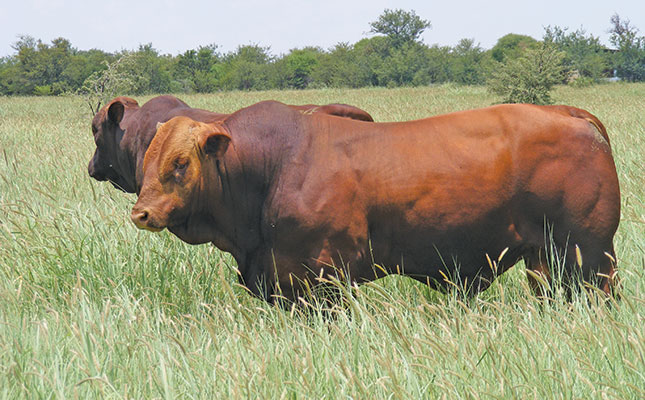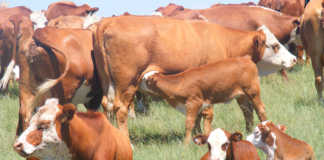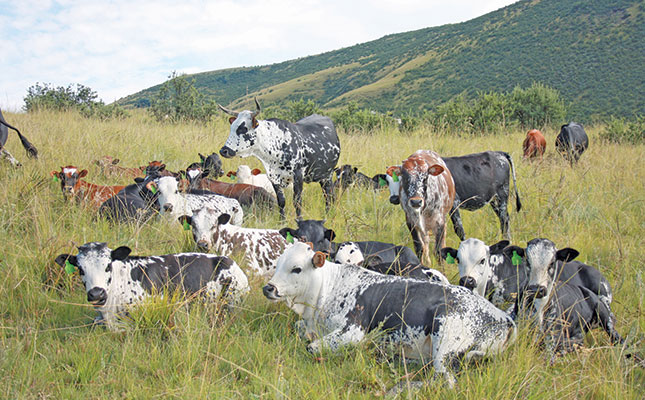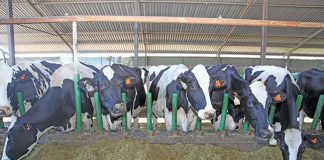
Photo: Bosveld Santa Gertrudis Study Group
The motto of the Bosveld Santa Gertrudis Study Group is: We think differently. The group’s quest is to provide the best possible veld-adapted genetics to the South African beef cattle industry.
To that effect, the group has implemented innovative bull veld tests coupled with strict selection processes. Farmer’s Weekly first reported on the activities of these breeders, then known as Santa Veldbeestelers, in 2014.
According to Naudé Pienaar, study group member from Buhrmansdrif in North West, the group has come a long way since then.
“We realised that we [Santa Gertrudis breeders] would have to expand our activities and increase our footprint in the beef cattle sector. The group now consists of 15 breeders, covering an area roughly from Polokwane to Mahikeng. The group runs about 2 500 pure-bred animals, including registered and non-registered Santas,” he says.
Correcting misperceptions
Breeding animals for the beef cattle industry revolves mainly around requirements and perceptions of the commercial breeder, according to Pienaar.
The main objective of the Bosveld Santa Gertrudis Study Group is therefore to breed and market animals that perform above average in an extensive environment (in the veld), as well as under intensive (feedlot) conditions.
Despite the fact that it has been proved many times that Santa Gertrudis cattle are top achievers, some outdated perceptions are still making commercial breeders reluctant to test these top grass and feed converters in their breeding programmes, says Pienaar.
The study group members are fully committed to the breeding of bulls reared on, and marketed from, the veld. Group member Wimpie Moolman says the group has proved the value and efficiency of veld-reared bulls and will proudly continue to spread this message.
Members are diligently focusing on not marketing overfed bulls that rapidly drop in condition and find it difficult to adapt to veld environments.
Beware of creep feed
Moolman cautions against buying bulls that are raised on creep feed from a very young age in order to achieve high weaning weights. After weaning, such bulls are typically kept on feed concentrates, often up to the age of 24 months.
“Since the animals are usually marketed at the age of 30 months, it doesn’t make sense to put them on veld for the last few months before marketing, so they are consequently fed until being put up for sale,” explains Moolman.
This means that the bulls never have an opportunity to adapt to natural grazing and to prove their worth as breeding sires in extensive farming conditions. Ferdi van Aswegen, another group member and animal nutritionist, explains that “more often than not”, the overfed bulls suffer from rumen problems, such as rumen acidosis, which makes it difficult for them to perform well on natural grazing.
Rumen acidosis is said to occur when the pH of the rumen falls from a normal level of between 6,5 and 7 to less than 5,5. The fall in rumen pH has two effects. Firstly, the rumen stops moving and becomes atonic, damaging the absorption area of the stomach. This depresses appetite and production.
Secondly, the change in acidity also changes the rumen flora, with acid-producing bacteria taking over.
“The primary cause of acidosis is feeding a high level of a rapidly digestible carbohydrate such as grain, and the damage to the digestive system is mostly irreversible.”
Van Aswegen further explains that a diet high in grains will also have a negative impact on bull fertility, due to the fact that the excess carbohydrates will be converted to body fat, and internal fat will be deposited in and around the testicles and will jeopardise the temperature regulation mechanism and result in permanent fertility problems, despite normal condition later.
On-veld performance
The excess amount of body fat will make a good impression on the eye, but can also result in a rapid loss in body condition when transition from high levels of feed to an extensive veld grazing system is experienced. “The most effective way to prevent this problem and ensure rumen health is to get animals used to natural grazing from a very young age,” says Moolman.
Whilst doing this, it was also critical to measure a breed’s ability to convert grass into beef. To this end, the study group initiated veld tests in 2009.
“We decided to run selected bulls on the veld for at least one winter and one summer season, and then weigh them monthly in the presence of non-breeders,” says Jacob van Zyl, a study group member from Zeerust.
“The extended test period enabled us to determine the bulls’ performance during four seasons, and particularly during winter. Our bulls’ performance was tested against another breed, a control group, run under the same conditions. The breed we chose as our benchmark is known for its excellent performance on the veld.” In all nine tests, the top performer was a Santa Gertrudis bull, with the other breed once achieving only fifth position.
Growth figures
Pienaar stresses that the bulls achieving growth figures better than the test average were then screened to ensure they met breed standards and were marketed at an age of more than 30 months.
Nine veld test sessions have been concluded so far by the study group, resulting in an established genetic base of top-performing bulls.
The genetic base includes bulls from, among others, the PZ bloodline and bulls such as Predictor XY 92 112, Toffieappel HB 80 029, SV 98 139 and the imported Kubecka 888, explains Moolman. One of the current sires, JHM 16 036, is a prime example of the type of bull the study group strives for.
One of the members, Tiaan Bekker from Modimolle, used him for six months from November 2020 to the end of May 2021 on a group of 50 cows, of which 42 became pregnant. Pienaar used him during the past winter, from 1 July to 6 September 2021, for 70 days without giving him supplementary feed. At the time of going to print, he was already back in Modimolle, ready for his next breeding session.
According to Pienaar, Santa Gertrudis veld bulls’ proven adaptability, fertility and hardiness make them an ideal choice for every farmer wishing to produce calves that are small when born, achieve superior weaning weights, and possess the added bonus of proven top feed conversions and exceptional carcass yields in feedlots.
To further market and prove the value of Santa Gertrudis genetics, the study group has assisted a number of emerging farmers in areas such as Mahikeng and Brits to artificially inseminate some 200 cows with semen donated by members of the study group.
Feedback from breeders in Botswana has also been encouraging. For example, Botswana beef producer Tikina Busang resorted to using Santa Gertrudis veld bulls because of the animals’ adaptability, fertility and hardiness. “The veld bulls fare well in the harsh semi-arid farming conditions of the country. I’m particularly impressed by the bulls’ high fertility and the superb fertility rates of their progeny,” he says.
Crossbreeding
Research conducted by Van Aswegen confirmed the value added by Santa Gertrudis bulls to crossbred weaner production. His research project consisted of 75 commercial Bonsmara breeding cows, divided into groups of 25.
Bonsmara bulls were used for two of the groups, while a registered Santa Gertrudis bull was used in the third group. The bulls were used in the January to March 2018 breeding season and the calves were weaned at seven months.
The project was run on very extensive conditions in an area where heartwater and other tick-borne diseases are common.
Birthweights, three-month and seven-month weights were recorded, using the same set of calibrated scales. The calves were weighed at the same time as well, between 9am and 11am. The cows were inspected two to three times per week during gestation to ensure they were healthy and in top condition.
“All the research results are available, but suffice to say that the Santa group’s weaner weight surpassed the control group’s weights by 13,68%, with the control group weaners weighing in at an average of 230kg and the Santa crossbred weaners weighing in at 261kg on average. At current prices, it means that the Santa calves brought in R1 240 more than the others,” states Van Aswegen.
Phone Naudé Pienaar on 082 776 8283, or email him at [email protected].













